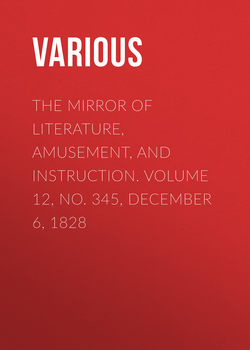The Mirror of Literature, Amusement, and Instruction. Volume 12, No. 345, December 6, 1828

Реклама. ООО «ЛитРес», ИНН: 7719571260.
Оглавление
Various. The Mirror of Literature, Amusement, and Instruction. Volume 12, No. 345, December 6, 1828
The Arch of Constantine, at Rome
THE BEGGAR'S DAUGHTER OF BETHNAL GREEN
HISTORY AND ANTIQUITY OF WILLS
The Cosmopolite
Fine Arts
The Anecdote Gallery
Manners & Customs of all Nations
WISE MEN OF GOTHAM
MALLARD NIGHT
WELSH MARRIAGES
CURIOUS FOUNDATION
THE SELECTOR, AND LITERARY NOTICES OF NEW WORKS
ADVENTURES OF ALLAN-A-SOP
ADVANTAGES OF A GOOD HEART,
SPIRIT OF THE Public Journals
QUADRANGLE OF KING'S COLLEGE, CAMBRIDGE
A RUSTIC PAIR
RECOLLECTIONS OF A R*T
THE FANCY BALL
The Gatherer
FRENCH BALL CONVERSATION
INTUITIVE AFFECTION
RETORT UNCOURTEOUS
Отрывок из книги
The popular ballad of "The Beggar's Daughter of Bednall-Greene" was written in the reign of Queen Elizabeth. It is founded, though without the least appearance of truth, or even probability, on a legend of the time of Henry III. Henry de Montfort, son of the ambitious Earl of Leicester, who was slain with his father at the memorable battle of Evesham, is the hero of the tale. He is supposed (according to the legend) to have been discovered among the bodies of the slain by a young lady, in an almost lifeless state, and deprived of sight by a wound, which he had received during the engagement. Under the fostering hand of this "faire damosel" he soon recovered, and afterwards marrying her, she became the mother of "the comelye and prettye Bessee." Fearing lest his rank and person should be discovered by his enemies, he disguised himself in the habit of a beggar, and took up his abode at Bethnal-Green. The beauty of his daughter attracted many suitors, and she was at length married to a noble knight, who, regardless of her supposed meanness and poverty, had the courage to make her his wife, her other lovers having deserted her on account of her low origin. Before entering, however, upon the ballad, it may not, perhaps, be thought irrelevant to give a brief sketch of the family of the De Montforts.
Simon de Montfort, created Earl of Leicester by Henry III., was the younger son of Simon de Montfort, the renowned but cruel commander of the croisade against the Albigenses. This nobleman was greatly honoured by Henry III., to whose sister, the Countess Dowager of Pembroke, he paid his addresses, and was married, with the consent of her brother. For the favour thus shown him by his sovereign, he, however, proved ungrateful: his inordinate ambition, cloaked by a pretended zeal for reform, was the cause of those rebellions which, in the reign of Henry III., kept the kingdom in such a continued turmoil. The different oppressions and successes of the confederate barons, who at length got possession of the king's person, and the civil wars which ensued, are so well known as to render any remark on the subject superfluous; suffice it to say, that the disputes between the malcontents and the royal party were at length terminated by the battle of Evesham, which decided in favour of the latter. In this field fell the Earl of Leicester and his eldest son, Henry de Montfort. His death was followed by the total ruin of his family; his titles and estates were all confiscated; the countess, his wife, who had been extremely active in her designs against the royalists, was banished, together with her sons, Simon and Guy, who afterwards assassinated their cousin, Henry d'Allmane, when he was endeavouring to effect a reconciliation between them and their uncle, Henry IV. The head of the earl was sent as a signal of the victory by Roger de Mortimer to the countess; but his body, together with that of his son Henry, was interred in the Abbey of Evesham; thus leaving the improbability of the legend without a shadow of doubt.
.....
5th. That they should be in their right minds, because testaments extorted through the phrenzy of a disease, or dotage of old age, were not in reality the wills of the persons that made them.
6th. That they should not be under imprisonment, or other constraint, their consent being then only forced, nor in justice to be reputed voluntary.
.....